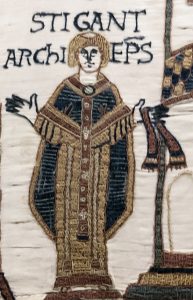Stigand was Archbishop of Canterbury at the time of Edward the Confessor’s death. He remained in the role until 1070. Stigand is known to have held ecclesiastical office from 1020 onwards, beginning in the reign of King Cnut. Edward the Confessor’s first appointment of a bishop was that of Stigand to Elham. Later he as promoted to the see of Winchester, holding both offices until 1057. Stigand was appointed Archbishop of Canterbury upon the deposition of Robert of Jumieges in 1052.
Historians views on the role of Stigand in the events of 1050-52 vary. Some think that Stigand was promoted to the see of Canterbury at the behest of the Godwine family, for his support in the conflict with Edward the Confessor. Others believe that it was Edward who wanted to reward Stigand for bringing about a peaceful conclusion to the events of those turbulent years.

Whichever view is accurate, Stigand inherited a politically sensitive position. The crown and the house of Wessex had feuded. Church lands held by the see of Canterbury were in and around those held by the Earl of Wessex, with much land disputed. The previous Archbishop had been deposed without the authority of the Pope. This led to challenges to his appointment: though these did not last long as Robert of Jumieges died the following year.
As Archbishop, Stigand had to stabilise internal relationships between these factions. He also had to contend with a reform programme that Pope Leo IX wanted. From a church perspective, Stigand was unelected. Political appointments were now frowned upon by Rome and Stigand, perhaps with this and the circumstances of Robert’s departure in mind, never made an approach for a pallium. The pallium is given to consecrated Archbishops by the Pope. It is worn around the neck as a visible sign of papal approval and authority.
To further complicate matters, Stigand had not been replaced as Bishop of Winchester. He also held office at a number of Abbeys. The papal reform movement forbid individuals holding more than one position. It is called pluralism. His failure to appoint a new bishop in his place at Winchester led to him being excommunicated by five successive popes. In Medieval England and Europe, excommunication was a matter of great importance.
An ‘Anti-Pope’ emerged as a challenger to the reforming church. This Pope did give Stigand a pallium. Briefly held, as the Pope died soon after, it legitimised Stigand for a short period. He used this to consecrate a number of bishops, though others had chosen to visit Rome to be consecrated by the Pope.
Stigand did attend council meetings with papal legates. This suggests that his position was recognised as being problematic. He was in a politically difficult position and while the church wanted to reform things, it was aware that the alternative could be much further away from their wishes.
The position of Stigand and the dispute over his legitimacy as Archbishop soon had larger implications. In 1066 he was present at the death of Edward the Confessor. He presided over Edward’s funeral. Sources also show that both he and the Archbishop of York were present at Harold Godwinson’s coronation. Norman sources claim Stigand performed the ceremony. as Stigand was not a legitimate Archbishop: he was excommunicated at the time; Harold had never been a legitimate King.
The Pope, Alexander II, gave papal backing to William of Normandy. Whether or not Stigand had performed the coronation, this act made his position awkward in the months to come.
After the death of Harold Godwinson at Hastings, Stigand is believed to have tried to negotiate with the Northern Earls to place Edgar the Ætheling on the throne. The plan was unsuccessful. Stigand and other leading members of the court submitted to William at Wallingford. Stigand was present at the Conqueror’s coronation, which was presided over by the Archbishop of York whose position was not challenged by the church.
Stigand was of use to the Normans in the early years of occupation and conquest. He was a valuable intermediary and could negotiate with Saxon lords. Following the crushing of rebellions, Stigand and other Saxon churchmen were not required. Papal legates from Pope Alexander II met with the Kings council. Stigand was charged with pluralism, theft of Robert of Jumieges’ pallium and the receipt of a false pallium from the Anti-Pope. He was deposed and sent into exile where he died in 1072.
The Domesday Book shows us that Stigand possessed a huge amount of land. In 1066 only the King and Godwinson had held more. When deposed, his land went to the crown. This was a major financial boost for William.
Note: When Thomas Becket challenged the King the Barons reminded him of the fate of Stigand.
The NormansFind out about the Norman monarchs and key features of Society during the Norman era from the menu below. |  |
|
| The Normans | ||
| Monarchs | ||
| William the Conqueror | William Rufus | King Henry I |
| King Stephen | ||
1066 | ||
| Claimants to the throne | Battle of Fulford | Battle of Stamford Bridge |
| The Battle of Hastings | ||
The Norman Church | ||
| Robert of Jumieges | Stigand | Odo of Bayeux |
| Lanfranc | Anselm | Ralph d’Escures |
| William de Corbeil | Theobald | Article: Anglo-Norman Church |
